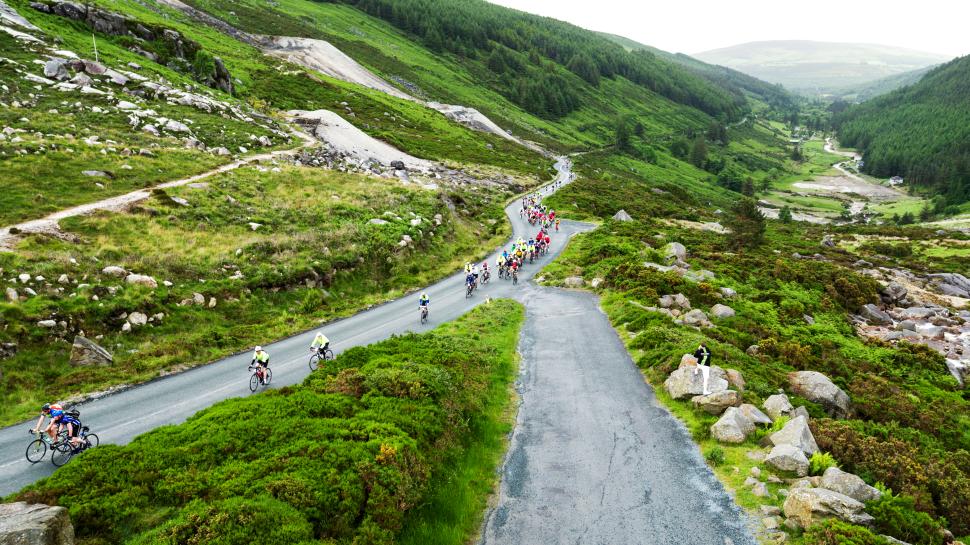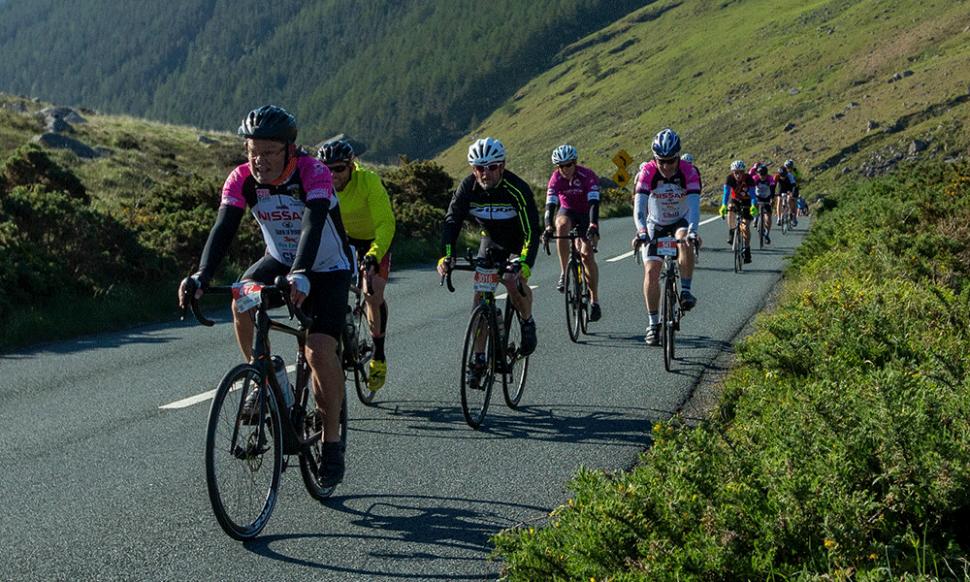- News
- Reviews
- Bikes
- Accessories
- Accessories - misc
- Computer mounts
- Bags
- Bar ends
- Bike bags & cases
- Bottle cages
- Bottles
- Cameras
- Car racks
- Child seats
- Computers
- Glasses
- GPS units
- Helmets
- Lights - front
- Lights - rear
- Lights - sets
- Locks
- Mirrors
- Mudguards
- Racks
- Pumps & CO2 inflators
- Puncture kits
- Reflectives
- Smart watches
- Stands and racks
- Trailers
- Clothing
- Components
- Bar tape & grips
- Bottom brackets
- Brake & gear cables
- Brake & STI levers
- Brake pads & spares
- Brakes
- Cassettes & freewheels
- Chains
- Chainsets & chainrings
- Derailleurs - front
- Derailleurs - rear
- Forks
- Gear levers & shifters
- Groupsets
- Handlebars & extensions
- Headsets
- Hubs
- Inner tubes
- Pedals
- Quick releases & skewers
- Saddles
- Seatposts
- Stems
- Wheels
- Tyres
- Health, fitness and nutrition
- Tools and workshop
- Miscellaneous
- Buyers Guides
- Features
- Forum
- Recommends
- Podcast
 Wicklow 200 (Kevin McFeely)
Wicklow 200 (Kevin McFeely)Cyclist killed during major sportive after hitting cracked and uneven speed ramp with “badly worn” markings and warning signs covered by vegetation, inquest finds
The son of a cyclist killed during a sportive after hitting a cracked and uneven speed ramp with “badly worn” markings, leaving him with severe brain and facial injuries, as well as multiple fractures, has called for improved signage to be used in future at similar events to alert cyclists to obstacles on the road.
But the organiser of the Wicklow 200, Ireland’s biggest cycle sportive, told a coroner’s inquest into the cyclist’s death that there are “inherent risks” to cycling, and that it was not possible to devise a route which completely avoided speed ramps and other potential dangers.
Belfast cyclist Patrick Kelly was killed when he crashed after hitting a speed bump on the outskirts of Ashford, Co. Wicklow, on 12 June 2022 during the Wicklow 200 sportive, the 39th edition of Ireland’s most popular leisure cycling event, which usually attracts around 3,000 cyclists every year.
The 62-year-old father of two, who was one of Northern Ireland’s best-known criminal lawyers, died from his injuries three days later in Dublin’s Beaumont Hospital.
On Thursday, a sitting of Dublin District Coroner’s Court heard that Mr Kelly was taking part in the sportive’s shorter 100km route with his friend, Peter Swan, when – around 30km from the finish – he hit a speed ramp while travelling at around 25-30mph on a slight downhill, losing control of his bike.
The inquest heard that Mr Kelly, whose helmet was not badly damaged in the crash, suffered severe brain and facial injuries as well as multiple fractures to his collarbone, shoulder blade, and ribs.
He was found at the scene to be unresponsive and bleeding significantly, and a postmortem confirmed that he died from severe, acute traumatic head injuries consistent with a fall from a bicycle.
A forensic collision investigator, Garda James Reynolds, told the inquest that the road surface at the location of the crash, on the L1096 between Glenealy and Ashford, was “cracked and uneven”, while the markings on the speed ramp were “badly worn.”
“In plain English, it was not in good nick,” he said of the condition of the road and the speed ramp, or “speed cushion”, due to it not covering the full width of the road.
The investigator also pointed out that a sign alerting road users to the speed ramp was partially covered by vegetation, while it also contained another warning about a “community alert area”.
Reynolds observed that there were no additional signs put in place to alert cyclists to the speed ramp, which he said were common at other cycling events he had attended.
Reynolds continued to note that Mr Kelly’s bike computer showed he was riding at 35kph at the time of the collisions, before slowing significantly, indicating “something had gone wrong”. The officer said the 62-year-old slid for around 18 metres after coming off his bike, which was found to not have suffered any technical or mechanical fault before the crash.
The investigator noted that it was not possible to say why Mr Kelly had slowed down at that moment, but he concluded that the condition of the speed ramp could have been a contributory factor.
> Inquest into Oxfordshire sportive rider's death to focus on event safety
The organiser of the Wicklow 200, Oliver Kirwan, told the inquest that an ambulance had arrived at the scene of the crash within five minutes of being alerted to the incident, the seriousness of which he said he had not experienced before during his time organising the sportive.
Mr Kirwan added that a subsequent review of the emergency response, including the deployment of a rapid response unit, was deemed satisfactory as all actions had been undertaken in a “professional and timely” manner.
Kirwan told the hearing that it was the personal responsibility of all participants to decide if the event was suitable for them, and that the organisers had carried out a risk assessment of the proposed route months in advance to ensure it was both “challenging and as safe as possible”.
The organiser, who noted that the route had been changed the following year for “logistical” reasons not relating to the fatal crash, also told the coroner that there were inherent risks to cycling on Irish roads.
He confirmed that the roads were not closed for the event, but marshals were in place along the entire route.
Kirwan also said there were eight speed ramps in total on the route for the 2022 edition of the Wicklow 200, and argued that it “would not be possible to devise a route that completely avoided speed ramps”.
He nevertheless acknowledged that speed ramps were not identified as a specific risk in the information provided to participants prior to the sportive.
Patrick Kelly
The coroner also heard evidence that Mr Kelly had suffered problems with his left eye for a number of years prior to his death, including cataracts and glaucoma.
A consultant ophthalmic surgeon, however, told the inquest that the cyclist had reduced vision in his left eye, but no limitations had been placed on him driving as his other eye had normal vision.
His wife, Doreen Kelly, said he was very fit and well and that she had no concerns about his participation in the Wicklow 200.
Mr Kelly, a partner at Belfast legal firm McConnell Kelly for over 30 years, had retired from practising law just a short time before his death.
His son, Rory Kelly, expressed a wish that improved markings would be used in future to alert cyclists to speed ramps at sportives like the Wicklow 200.
A jury of four men and two women returned a verdict of accidental death but made no recommendations.
After obtaining a PhD, lecturing, and hosting a history podcast at Queen’s University Belfast, Ryan joined road.cc in December 2021 and since then has kept the site’s readers and listeners informed and enthralled (well at least occasionally) on news, the live blog, and the road.cc Podcast. After boarding a wrong bus at the world championships and ruining a good pair of jeans at the cyclocross, he now serves as road.cc’s senior news writer. Before his foray into cycling journalism, he wallowed in the equally pitiless world of academia, where he wrote a book about Victorian politics and droned on about cycling and bikes to classes of bored students (while taking every chance he could get to talk about cycling in print or on the radio). He can be found riding his bike very slowly around the narrow, scenic country lanes of Co. Down.
Latest Comments
- JMcL_Ireland 42 min 28 sec ago
May the poor man rest in peace....
- wtjs 46 min 21 sec ago
in other cycling cases, they've been dropped before trial b/c a prosecutor gets hold of the file & can back down ...
- Freddy56 47 min ago
Story one: "Here is all the deals at 50% off."...
- andystow 1 hour 31 sec ago
Front wheel trued and tensioned last night. I think it took me well over an hour.
- andystow 1 hour 4 min ago
Definitions aside, that is a ridiculous amount of cardboard. Is the double wall really necessary to protect the product?
- Clem Fandango 1 hour 14 min ago
It used to (literally) be a cattle market.... How on earth did anyone survive??? https://heritagesearch.oxfordshire.gov.uk/images/POX0626282
- quiff 1 hour 23 min ago
From the article above.
- quiff 1 hour 27 min ago
If you watch him climbing Shap, the gearing doesn't look great. From the linked article:...
- bensynnock 1 hour 28 min ago
You'd just get dog walkers on it with a 30m lead.


Add new comment
2 comments
May the poor man rest in peace.
I was on that route and nearly came a cropper at those same speed bumps. They were lethal and almost entirely invisible. I'm not sure whether Mr Kelly crashed before or after I came through - one of the locals was out flagging people to slow down so maybe after. While I wasn't aware of the crash on the day, that spot is the first thing that came to mind when I heard it.
The organiser isn't shy of charging for the event which came to around €100 all told. This is par for the course for sportifs run by this organisation (read all the major ones in Ireland) on open roads. While I can't fault the marshalling on the WW100 in general, value for money has gone down the drain in recent years and it's difficult to see where it's gone to - certainly in this case not to highlighting this which should have been an obvious catch coming as it does after a long descent.
It'd appear the sportive organizer is particularly uncaring. They are asking for extra signage prior to speed bumps, not change the route or other things. You'd think they'd go yes we can add signs at the speed bumps and other areas of added risk. Having done a few mass start events, what is not a risk when riding solo is a risk when ridden with others side by side. Think I'd avoid this Sportive if I lived in Ireland, if that is how the organizer is towards the people who pay money to enter their events.